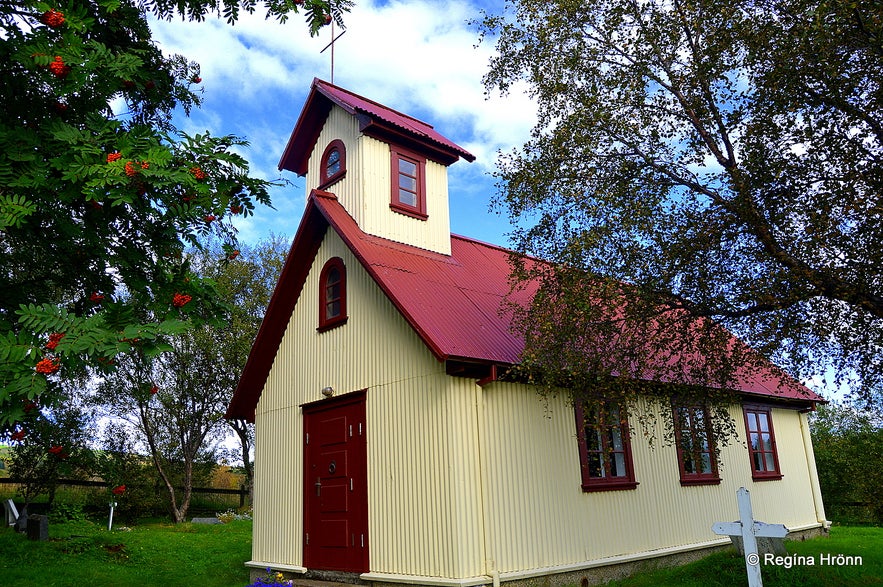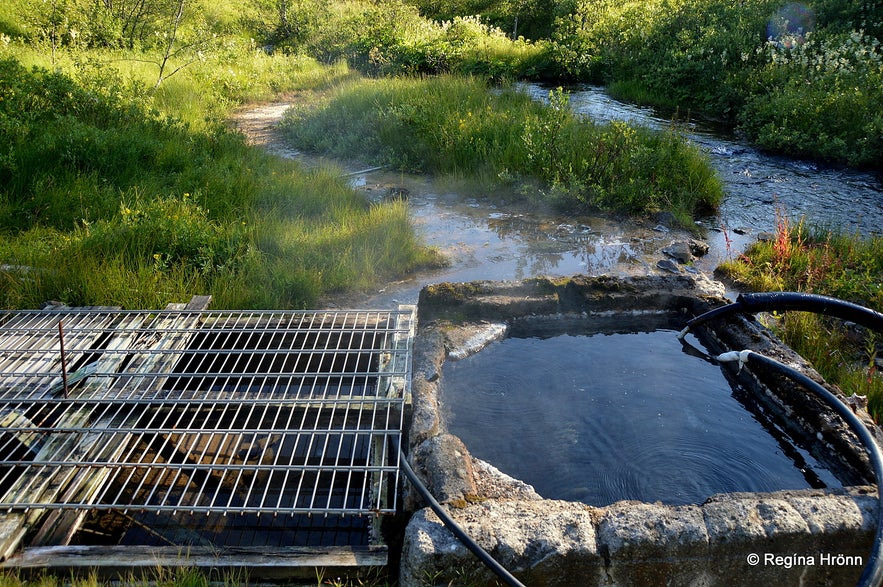
The Icelandic Haukadalsskógur Forest, Marteinshver hot spring, and a dip in Kúalaug hot pool


Next to the very popular Geysir geothermal area in South Iceland, you will find one of our national treasures; the huge Haukadalsskógur forest - Iceland standard -, a lovely church, and a small geothermal pool in which one can bathe.
Very few people visit it as they go straight from Geysir to Gullfoss waterfall, which are 2 of the main attractions of the Golden Circle, which is the most popular day tour in Iceland.
Top photo: wood cutting in Haukadalsskógur
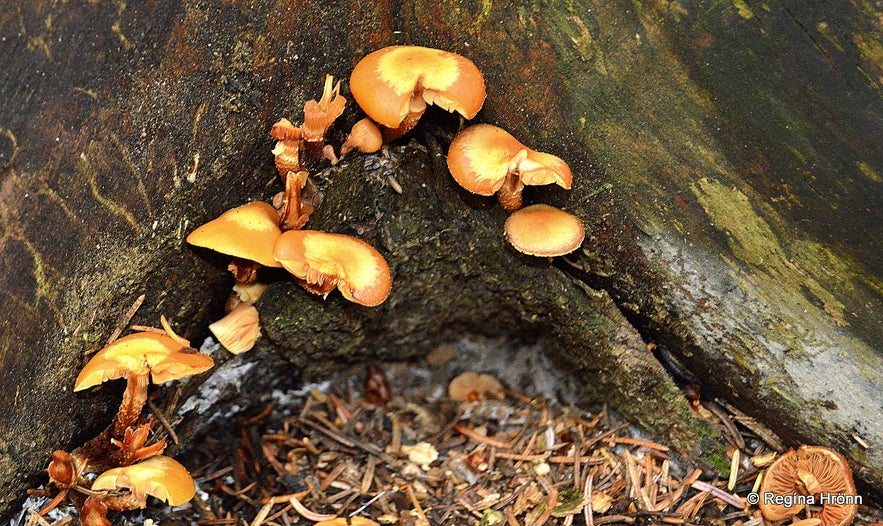
Mushrooms in the forest
Haukadalsskógur forest is the most highly cultivated of the national forests in Iceland and one of the biggest national forests in South Iceland. We Icelanders don't have that many forests so we love our few forested areas.
Landnámabók - the Book of Settlement, in which you can read about the Settlement of the Vikings in Iceland, describes Iceland as having been forested from the mountains and all the way down to the sea.
It is very different from the Iceland I know, although my country is becoming more and more forested now due to forestation. But we had very few trees when I was growing up.
The Vikings are said to have used the plentiful wood excessively and allowed their livestock to roam around free in the forests, which seems to have resulted in denudation. Now we try to keep our sheep away from national parks and sensitive areas, as we don't want our country to blow away out to sea due to soil erosion.

Monument in the forest for Kristian Kirk
But other factors also added to denudation, for example very cold periods and the frequent volcanic ash fall from the nearby volcano Hekla. These factors were the cause o the Haukadalsheiði heath having become one big desert and putting the Haukadalur valley at risk.
Fortunately, a Danish tycoon, Kristian Kirk, bought a part of Haukadalur valley in 1938, and measures were taken to protect this area from soil erosion. Kristian died only 2 years later and left his land to Skógrækt ríkisins - the Icelandic Forest Service - all 1,600 hectares of it.
The Icelandic Forest Service continued with the forestation and declared the Haukadalsskógur forest as protected. You will find Kristian's monument by the driveway to Haukadalur.

Berries in the forest
Now this area is one of the most spacious revegetation sites in Iceland. If you want to drive up to the heath a 4x4 is needed as further on this road is numbered F-338, the F standing for fjallvegur, which is the Icelandic term for a mountain road.
To me, Haukadalsskógur is a hidden pearl and I love walking around in between the tall trees, something which our foreign visitors are for sure used to, but we Icelanders consider to be a unique experience :) So we Icelanders visit our few forests a lot.
You will find many trails in Haukadalsskógur and even a customized trail for wheelchairs, which was made in cooperation with Sjálfsbjörg, which is our Icelandic federation of movement-impaired people.
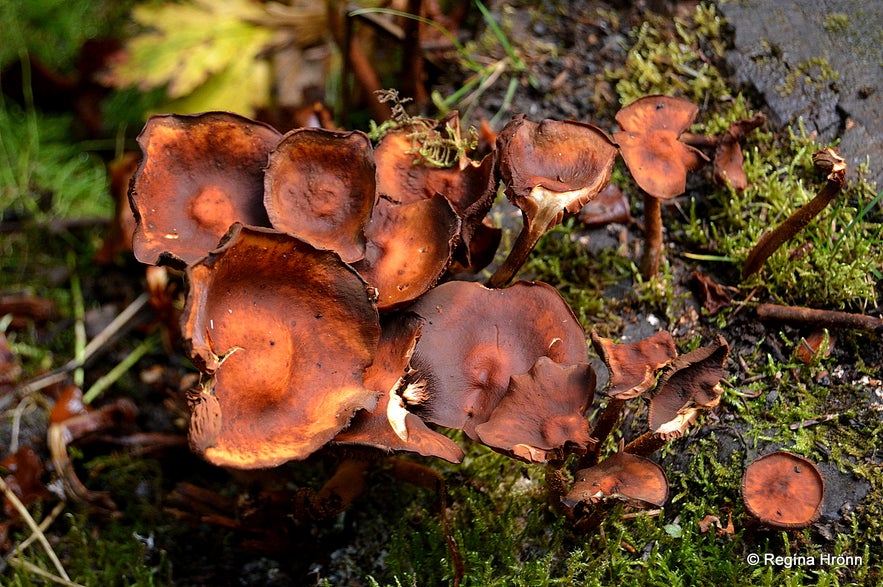
Mushrooms in the forest
Seeing that Haukadalsskógur is a cultivated forest then forestation experiments are made here, and we can even buy our Christmas trees from this beautiful forest. As you can see in my first photo, which is a rare sight in Iceland, then the thinning of the forest takes place.
I was in awe when I saw this huge pile of logs, as this is something I have only seen abroad. I guess you must be used to this sight in your own country.
Now a little bit of history, seeing that Haukadalur valley is a historical place and one of the study centres of Iceland back in the early days.
The settlers in Haukadalur were Þorbrandur Þorbjarnarson and his son Ásbrandur. Then Hallur Þórarinsson the mild built his farm here in 1025. The noted Ari fróði Þorgilsson - Ari the Wise (1067-1148), who belonged to the Haukdælir clan, stayed with Hallur for 7 years, from age 7-14.

Mushrooms in the forest
Ari the Wise has been called the father of Icelandic historiography as he is best known for writing Íslendingabók or the Book of Icelanders, which tells us about the early history of Icelanders. Íslendingabók is the first written work of history in Iceland from the Settlement of Iceland until 1118.
Ari the Wise is said to have returned back to Haukadalur to write the Book of Icelanders when he was almost 60 years old.
From the 11th century until the 13th century - for 174 years - the manor of the big Viking clan Haukdælir was located in Haukadalur. The patriarch of the Haukdælir clan was the priest Teitur Ísleifsson at Haukadalur (d. 1111), who was raised by the same Hallur Þórarinsson as Ari the Wise had stayed with for 7 years.
Teitur was the son of the first Icelandic bishop, Ísleifur Gissurarson (1006-1080). So we can for sure say that Haukadalur is a historic place.
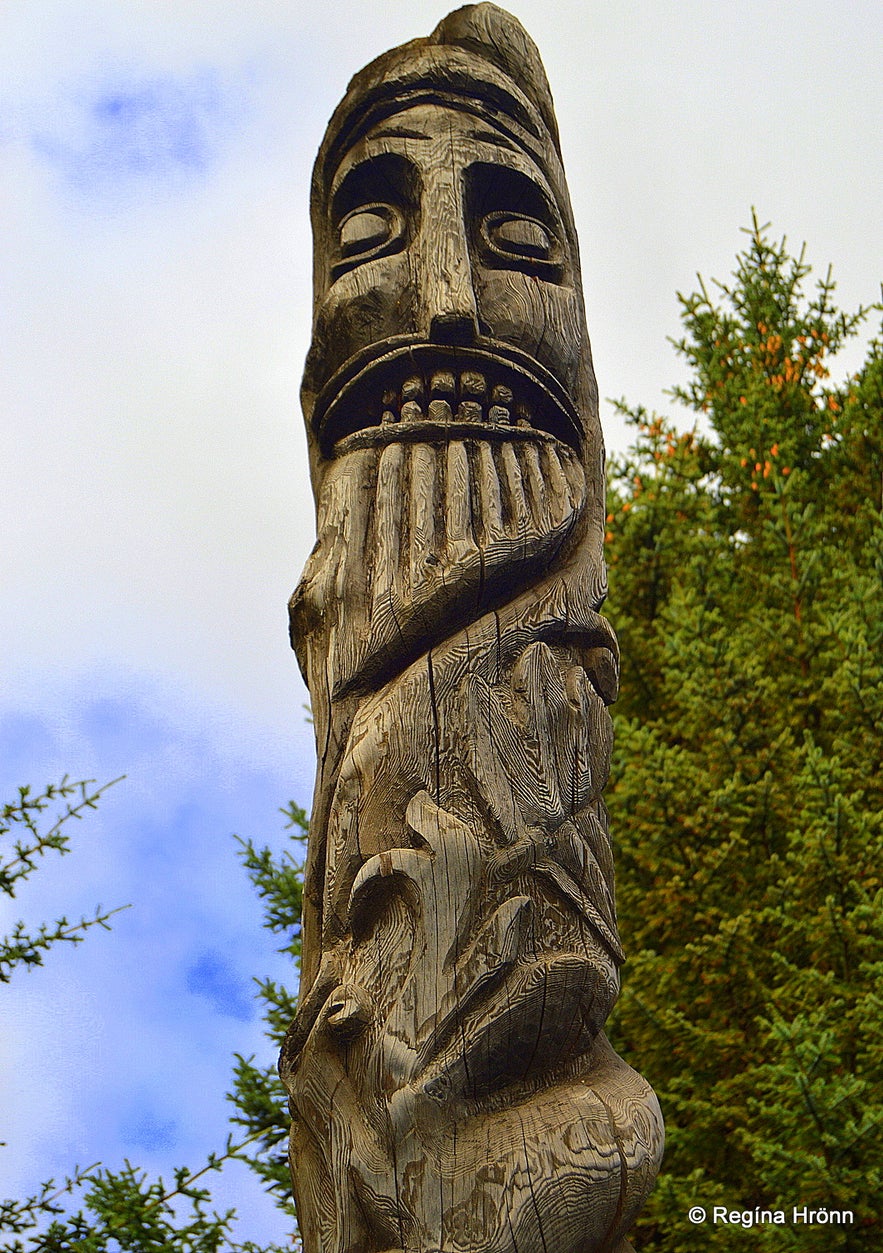
The monument for Hákon Bjarnason
Now, back to talking about my visit to Haukadalsskógur forest. We explored the parts of the forest closest to the road and down to the river on the west side.
We found a lovely picnic area with a totem pole in the middle of the grove. This grove is called Hákonarlundur grove in memory of Hákon Bjarnason (1907-1989), who was the forestry director from 1935-1977.
The pole was erected in 1999 on the 100th birthday of forestation in Iceland and the 60th birthday of forestation in Haukadalur valley. The pole was carved by Guðjón Kristinsson and the carvings refer to the history of forestation in Iceland and show the landvættir - the land wights of Iceland, who protect the north, south, east, and west parts of Iceland.

The information sign about Hákon Bjarnason
You will see the rock giant of the south perching at the top of the pole and the other wights further down, the bull, the eagle, and the dragon.
Other signs have been carved out in the pole, the Russian bear, the Norwegian elk, and the bald eagle from Alaska, referring to some of the trees which have been planted in the Haukadalsskógur forest.
There is also the face of an American-Indian to be found seeing that this is a totem pole. Hákon was fascinated by this type of art, so the pole was erected to honour his memory and the great work he did for the Haukadalsskógur forest.
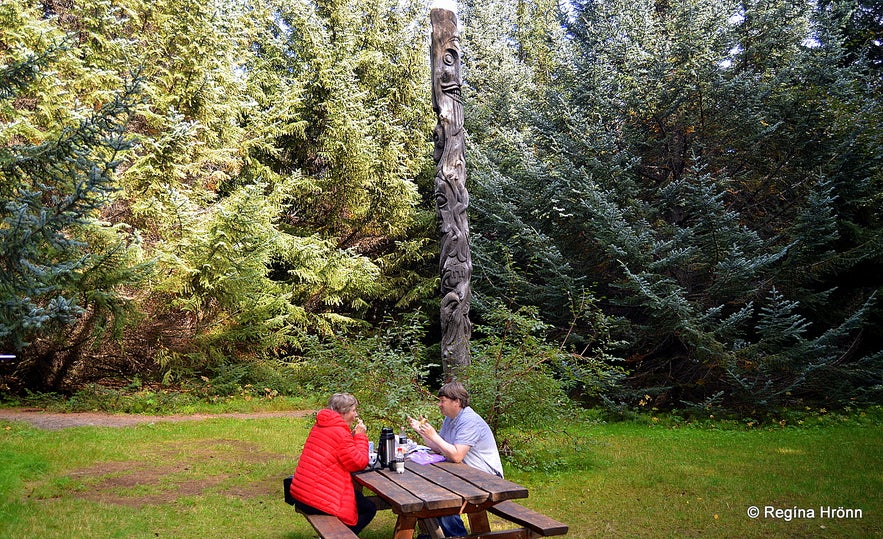
Having a picnic with my husband and my mother-in-law
We had a picnic by the totem pole; it was so lovely and a rare opportunity here in Iceland to have a picnic in an actual forest.
We do have a cultivated forest in Elliðaárdalur valley in the middle of Reykjavík, which I visited often as it was next to my former home, where I lived for 28 years, but you can hear the traffic noise in the city, here in Haukadalur forest we couldn't hear anything but the birds singing.
Haukadalskirkja church
Haukadalskirkja church
Haukadalskirkja church is one of the many lovely country churches which you can see all around Iceland.
I love visiting these churches and on my travels in my country, I pop in for a visit to as many churches as I possibly can.
Unfortunately, they are almost all locked now due to vandalism so I have to find the key to be able to enter, which is not always that easy.
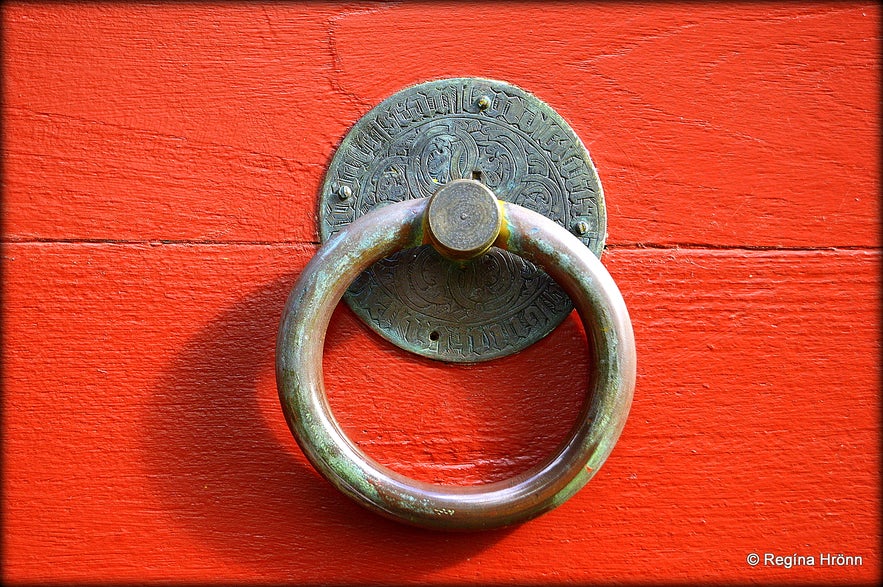 Folklore tells us about the origin of this ring on the church door
Folklore tells us about the origin of this ring on the church door
Haukadalskirkja has always been locked when I visit this area, and I didn't know whom to call to be able to enter. So I could only peep through the windows.
It is such a pity that we have to keep these lovely churches closed. I wished we could all just respect them so that everybody would be able to enjoy these little gems dotted around my country.
You will find a shield on the red-painted church door with a ring attached to it. Folklore is related to that ring.
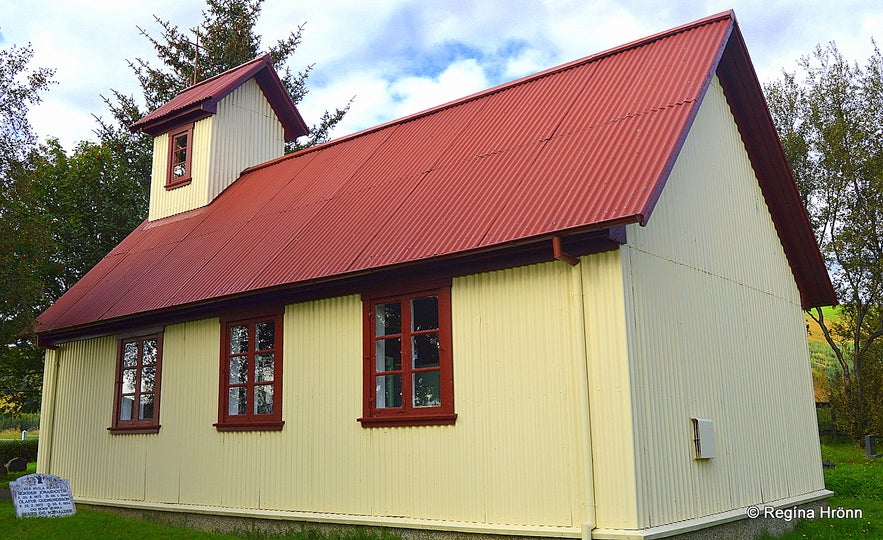
Haukadalskirkja church
Haukadalskirkja is regarded to be one of the oldest timber churches in Iceland. It was built in 1842-43 and rebuilt and enlarged in 1939 by Kristian Kirk.
There has been a church in Haukadalur at least since 1121 (some say 1030) and the current church stands on the same foundations as that church.
In Catholic times Haukadalskirkja church was dedicated to God, Virgin Mary, St. Andrew, Bishop Marteinn, and St. Barbara.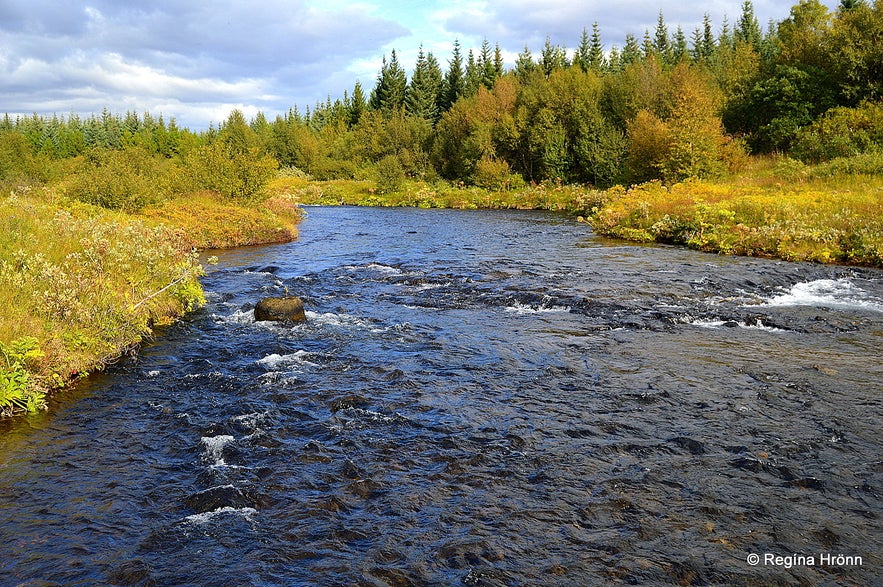
Beiná river
The river Beiná - the Bone river runs by the church and the old Haukadalur farm stood east of the church. There are supposedly bone remains in the Beiná river, thus the name.
In another travel-blog, I told you about the giant Bergþór in Bláfell, whose memorial stone you will find by the church:
The gentle Troll Bergþór in Mt. Bláfell - Icelandic Folklore from South Iceland
Marteinshver hot spring and Kúalaug hot pool
Marteinshver hot spring - it is 80-100 degrees C hot - do not bathe here!!
Seeing that this area is located next to the highly geothermal area of Geysir then there is geothermal activity in the Haukadalsskógur forest.
The best-known is the protected Marteinshver hot spring, which was used earlier for heating up water in a swimming pool for swimming lessons for the inhabitants in the neighbouring areas.
There was a hut above the hot spring to create a steam bath and potatoes were cooked in the hot spring and laundry was done here as well.
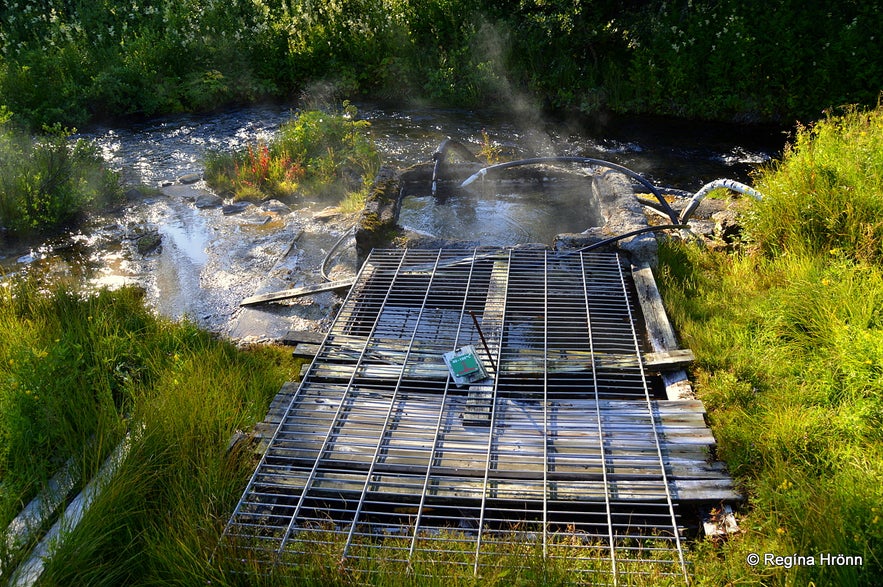
Marteinshver hot spring - this is the hot spring and not the hot pool!
In my childhood, there was a small hut above the hot spring in Laugarvatn, where we always used to stop and take a steam bath, free of charge.
Now a spa has been built, which uses the geothermal heat from the hot spring in Laugarvatn. It is called Fontana and deserves a visit if you want to be spoiled.
Marteinshver hot spring is by the river on the west side of the church, very difficult to find and it is best to leave it alone as it is so frightfully hot; 80-100 degrees hot! It is now preserved and used to heat up the building of the Icelandic Forest Service.
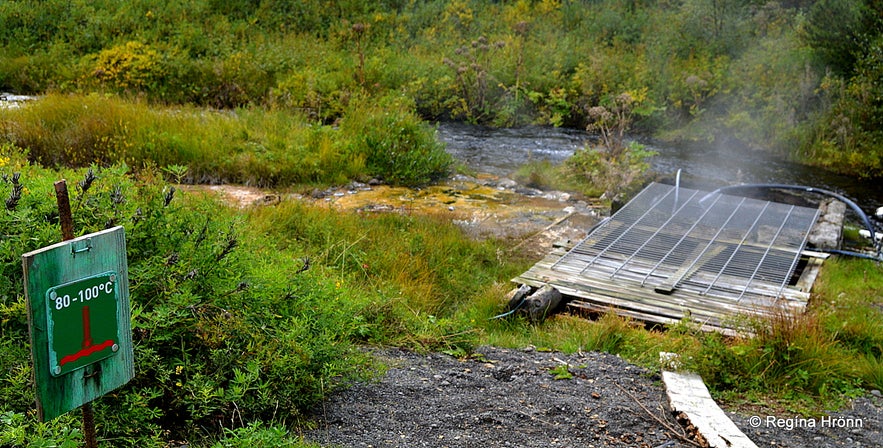
80-100 degrees C hot!!
There is a pool by the name of Marteinslaug, which I didn't find. I have seen it mentioned with photos of Marteinshver hot spring, which is frightening, as that is a scolding hot spring! Marteinslaug is 220 meters west of the Marteinshver hot spring according to Geysir fornleifaskráning.
By the road is Kúalaug which is suitable for bathing.
Kúalaug hot pool
Kúalaug hot pool
There are 3 hot pools in this area, Kúalaug, Matarlaug, and Sokkalaug. Matarlaug is around 70 degrees C hot and Sokkalaug is around 25 degrees C hot, but Kúalaug has the perfect temperature of 38-40 degrees C.
Kúalaug consists of 2 pools, one bigger and one smaller pool, which is surrounded by stones to define it. I have only had a foot bath in it, but I think that it is big enough for 4-6 people to bask in and enjoy.
Kúalaug is right by the road before you reach Haukadalskirkja church and is easily accessible. There are no changing facilities though, so if you want to visit it, it would be best to wear your bathing suit inside your clothes and leave your clothes on the grass by the pool.
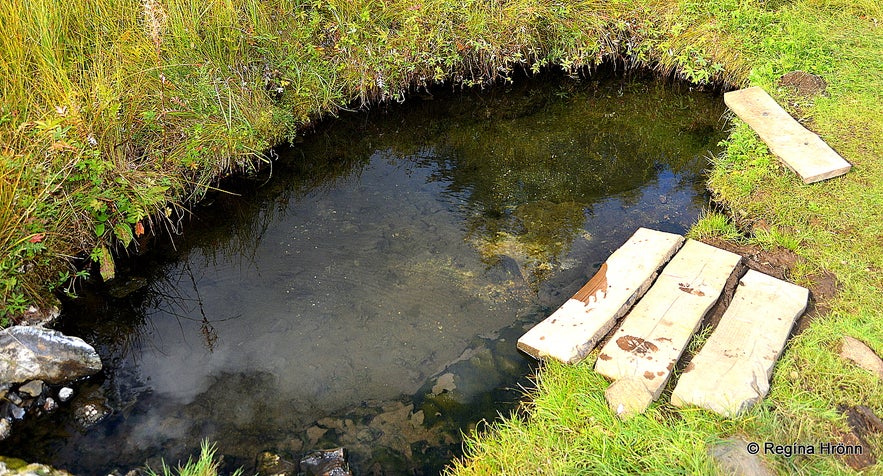
Kúalaug hot pool
Always wear a bathing suit when bathing in our hot pools, especially when they are right by the road like this one.
The pool edges can become slippery in the rain and since it is a natural pool then there is vegetation at the bottom of the pool and it can become slippery.
Always check the water temperature before entering natural hot pools; this is nature and the temperature can change. When I last visited this area in 2020 Kúalaug had got a lot of vegetation and did not look inviting to bathe in so I only took a footbath in the pool.
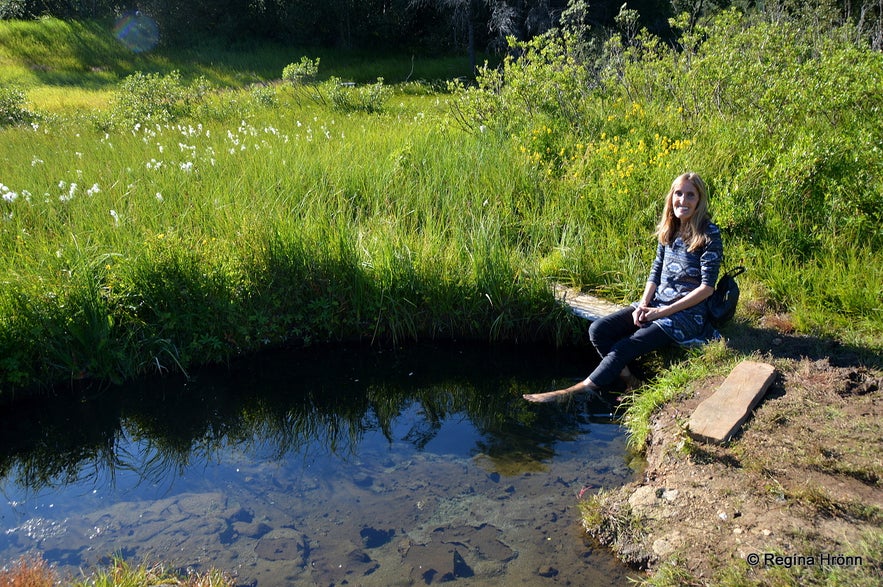
Having a foot bath in Kúalaug
Don't miss visiting this lovely area while in Iceland. I am aware that our foreign visitors are on a tight schedule and want to see the highlights of the Golden Circle, but now you know that the surrounding area also has gems, which are hidden from sight.
Kúalaug is in South Iceland, 2 km away from Geysir. Drive to Geysir on Route 35, then onto Route 333. The road is marked as F-333 but doesn't turn into an F-road until later. The pool is right by the road on the left-hand side, just before you reach the church.
Here you can see the location of the Kúalaug hot pool on Google maps. If you want to drive to this place you can rent a car in Reykjavík and drive there in less than 2 hours - there are plenty of interesting stops on the way.
You can also check out the various Golden Circle Tours.
Have a lovely time at Haukadalsskógur forest :)
Ref.:
Inne ciekawe blogi
Gorące źródła - Hrunalaug
Z czego słynie Islandia? Zorza polarna, wulkany, lodowce, gejzery i oczywiście gorące źródła! Hruni, a właściwie Hrunalaug to gorące źródło w malowniczym otoczeniu, znajdujące się w w pobliżu miejscowCzytaj więcejPolowanie na Zorzę
Zobaczenie zorzy polarnej to marzenie wielu osób. Zorza jest dla mnie czymś magicznym i niepowtarzalnym, zachwyca mnie za każdym razem. Czy faktycznie tak ciężko ją dostrzec? Otóż nauczyłam się, że niCzytaj więcejO pisaniu na Guide to Iceland
Mam wrażenie, że na Islandii bardzo wiele rzeczy staje się jasnych. Chodzi o podejście do świata, do własnej osoby, do innych, którzy realnie wpływają na Twoje życie. Islandia zmusza swoją surowościCzytaj więcej

Pobierz największą platformę turystyczną na Islandii na telefon i zarządzaj wszystkimi elementami swojej podróży w jednym miejscu
Zeskanuj ten kod QR za pomocą aparatu w telefonie i naciśnij wyświetlony link, aby uzyskać dostęp do największej platformy turystycznej na Islandii. Wprowadź swój numer telefonu lub adres e-mail, aby otrzymać wiadomość SMS lub e-mail z linkiem do pobrania.
